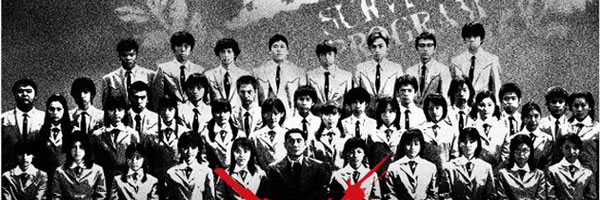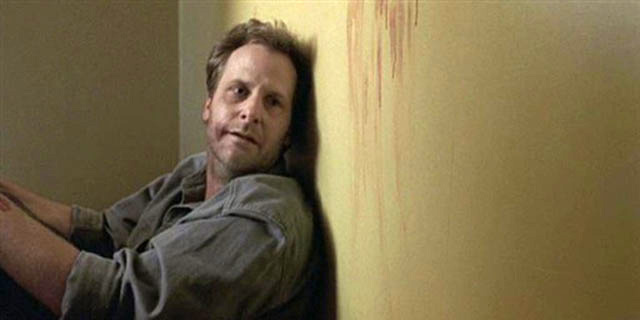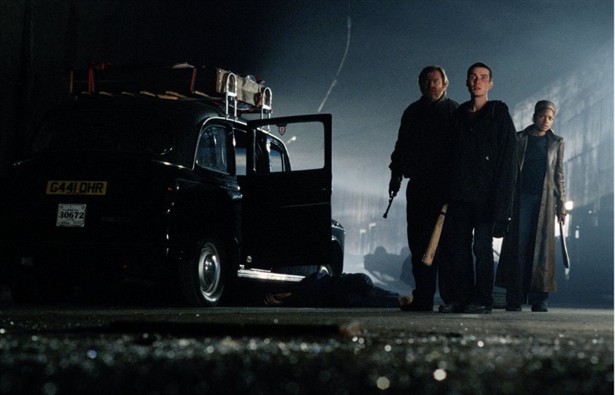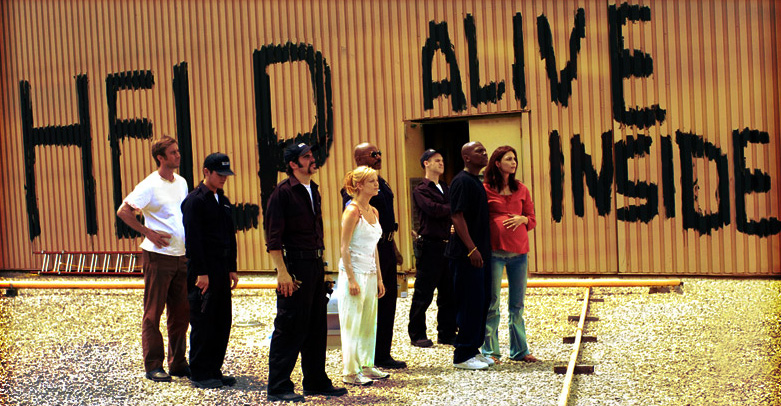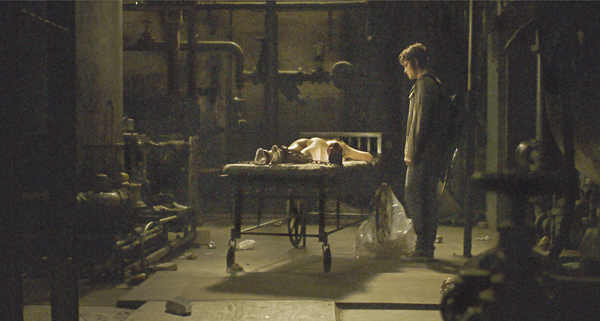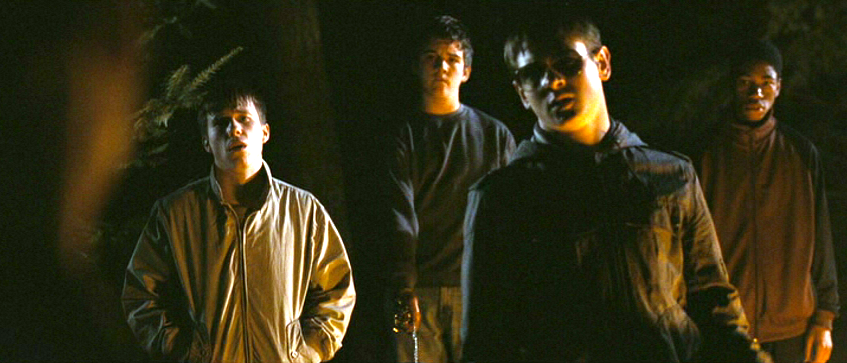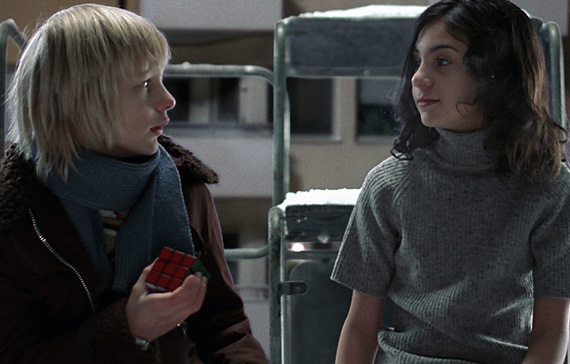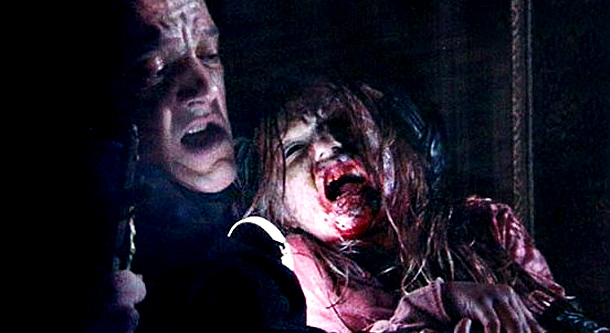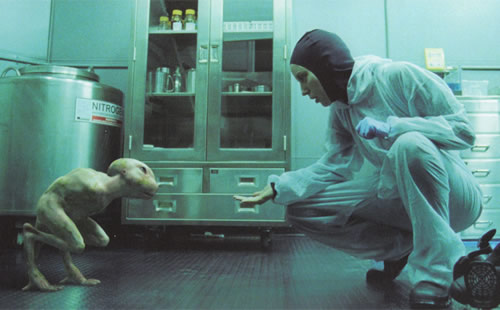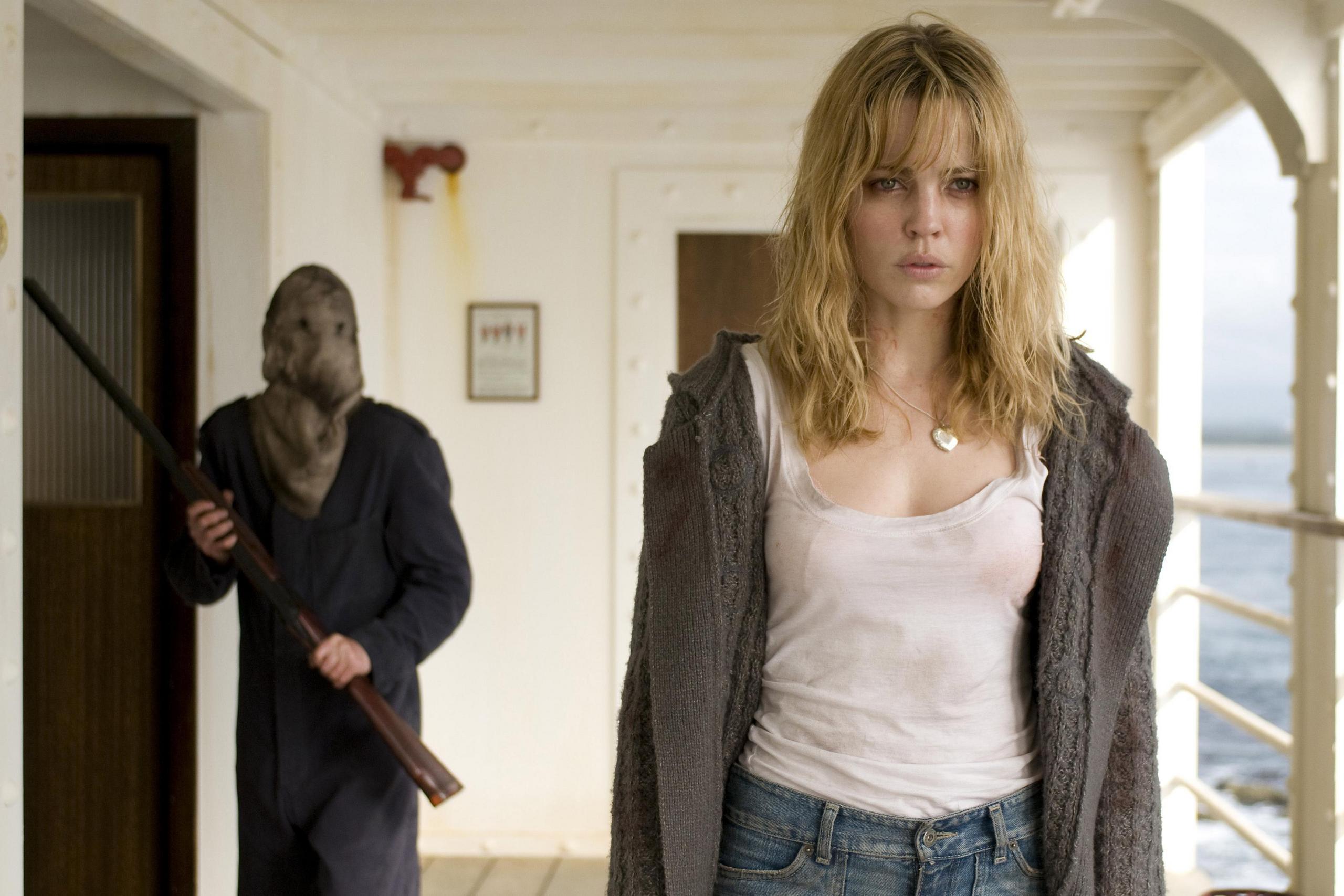Many film websites published “decade’s best horror films” lists in late 2009/early 2010. While these lists collectively provided a rough snapshot of the genre’s ups and downs during that time, with more time to reflect, it becomes increasingly clear what an important period the 2000’s were for the horror genre on a global scale.
Not only did this decade easily and obviously eclipse the comparatively arid 1990’s in both volume of production and overall quality, the 2000’s can also be looked at as a crucial one for horror cinema despite the justified outrage about the American film industry’s widespread strip-mining of classics and foreign films for remakes/re-boots and its saturation of the market with teen-friendly PG-13 rated horror films.
While by no means as groundbreaking as the 1970’s or as sentimentally regarded as the 1980’s, the 2000’s will be recalled as the decade that, despite well-founded criticisms about the lack of creativity and edge in America’s horror film output, globally produced an impressive number of truly outstanding films in the genre.
In addition to this notable achievement, the 2000’s also saw the rise of the most widespread international horror film boom in cinema history as countries with relatively small histories of horror film production joined resurgent usual suspects to become places to watch for horror films.
While American horror film production was booming and a new wave of British horror started to emerge, France and Spain became the European genre hotbed Italy had been in the 1960’s, 1970’s and 1980’s. In Asia, South Korea and Thailand joined surging perennial favorite Japan as prime producers of horror films. With this all-important door kicked open in the 2000’s, this international trend continues to grow and expand to this day as we see more horror films coming out of Indonesia, various countries in South America and the list goes on.
Following is a chronological list of the great horror films of 2000-2009, followed by several related lists designed to give a deeper look into the genre decade.
Note: As the age-old argument about what defines a horror film rages on, it should be noted that horror cinema is defined here in a broad way in the vein of Kim Newman’s landmark book Nightmare Movies, so this article contains some films that can be considered to belong to other films genres as well as horror.
****
1)The Best Horror Films of the 2000’S
The Crimsons Rivers (Mathieu Kassovitz, 2000, France)
Tattoo (Robert Schwentke, 2002, Germany)
Empire of the Wolves (Chris Nahon, 2005, France)
Waz (aka The Killing Gene, Tom Shankland, 2007, UK):
These four films, all centered around a pair of detectives investigating bizarre and gruesome murders, are grouped together here because they are all influenced by David Fincher’s classic Seven (1995, USA) and like that milestone film combine elements of horror (in the psychopath subgenre) with the crime and suspense thriller genres.
The Crimson Rivers, Tattoo and Empire of the Wolves are all stylish and atmospheric while Waz presents a gritty, film noir-influenced take on moral confrontation that is much less flashy and far more effective than Saw (James Wan, 2004, USA).
It should also be noted that The Crimson Rivers and Empire of the Wolves (both based on novels by French writer Jean-Christophe Grange) are must-sees for fans of the great French actor Jean Reno, who turns in very memorable performances in both films, one as driven police detective and the other as a disgraced crooked cop with heavy connections in the Turkish criminal underworld.
Olivier Dahan’s sequel Crimson Rivers 2: Angels of the Apocalypse (2004, France) should be avoided at all costs by admirers of the original film.
Battle Royale (Kinji Fukasaku, 2000, Japan):
This is a film that’s truly deserving of its status as a contemporary genre classic. In the near future, a group of students are pitted against each other in a fight to the death on an isolated island. Not to be missed by anyone hasn’t caught up with it yet. If you love this film, based on a novel by Koushun Takami, run as far away as you can from 2003’s supremely disappointing Battle Royale 2 (Kenta Fukasaku & Kinji Fukasaku, Japan), a film justifiably held in very low critical regard.
Chasing Sleep (Michael Walker, 2000, USA):
This underrated and unjustly overlooked David Lynch-influenced film takes place entirely within the confines of one house. Jeff Daniels stars as a college professor with recent memory gaps whose wife has disappeared. Chasing Sleep is vastly superior to director Brad Anderson’s similar The Machinist (2004, Spain) which received far more attention, most likely in appreciation of star Christian Bale’s severe weight loss in preparation for the lead role as opposed to the overall quality of that incredibly predictable film.
Pitch Black (David Twohy, 2000, USA):
Director/screenwriter Twohy re-wrote an original screenplay by Jim and Ken Wheat and created a very enjoyable 1950’s throwback film about a group of stranded space travelers and a dangerous criminal facing off against flesh-eating nocturnal creatures as they attempt to repair an escape vessel. Pitch Black features a very good performance by Vin Diesel and was followed by a thoroughly horrendous sequel The Chronicles of Riddick (David Twohy, 2004, USA) that abandons the very successful man vs. alien elements of the first film and attempts to become an “epic”.

Vampire Hunter D: Bloodlust animated (Yoshiaki Kawajiri, 2000, Japan):
Legendary horror/fantasy/science fiction animated feature director Kawajiri, whose other landmarks films include Ninja Scroll (1993, Japan), the Cyber City Oedo 808 series (1990, Japan) and Wicked City (1987, Japan), re-envisions the 1985 animated film about futuristic bounty hunters with stunning results, eclipsing the original in every way. This is an absolute must-see for fans of darker animated films.
Brotherhood of the Wolf (Christophe Gans, 2001, France): \
Very enjoyable period horror/action/fantasy about a series of vicious killings perpetrated by a beast of unknown origin and the investigators sent by the king of France to investigate. Not all the elements fully come together script-wise but the film is highly entertaining nonetheless. It was a true shame that director Christophe Gans followed this success with the horrendous video game adaptation Silent Hill (2006, USA).
While we’re on the subject of shame, it was painful seeing Brotherhood of the Wolf lead actor Samuel Le Bihan wasted in a poorly written, clichéd character role as a hulking brute in director Xavier Gens’ by-the-numbers rural massacre film Frontier(s) (2007, France).
28 Days Later (Danny Boyle, 2002, UK):
This is an excellent apocalyptic film from director Danny Boyle and screenwriter Alex Garland. 28 Days Later takes elements from director/screenwriter George Romero’s first three Dead films (1968, 1978,1985, USA) and provides a fresh and entertaining spin on them, utilizing a virally infected population that overruns England in place of Romero’s trendsetting walking dead.
The success of this film produced a well-received but overrated and very poorly edited sequel 28 Weeks Later (Juan Carlos Fresnadillo, 2007, UK/USA).
Identity (James Mangold, 2003, USA):
This is an underrated Twilight Zone-ish film about a group of people trapped in an isolated motel. As an unseen assailant picks off the group one by one, a fascinating premise is revealed by director Mangold and screenwriter Michael Cooney. The film features not only a unique script but also solid ensemble acting spearheaded by John Cusack as a limousine driver/ex-cop with a fondness for reading Jean-Paul Sartre.
Dawn of the Dead (Zack Snyder, 2004, USA):
A remake of George Romero’s 1978 classic that, defying expectations, manages to emerge as its own film, and a very good one at that. Credit goes to a high quality script by James Gunn (who wisely chose to write his own take on the premise of the original instead of just executing a simple update), excellent directing by Zack Snyder and very solid ensemble acting by a game cast that includes Sarah Polley and Michael Kelly. The film’s opening sequence showing a suburban neighborhood being overtaken by the undead plague is a stunner.
In a sea of remakes spawned by the American film industry’s focus on “pre-awareness product”, this version of Dawn of the Dead succeeds where director Marcus Nispel’s very financially successful but creatively dead remake of The Texas Chainsaw Massacre (2003, USA) and the many horror film remakes that continue to follow fail, emerging as a contemporary classic.
Shutter (Banjong Pisanthanakun & Parkpoom Wongpoon, 2004, Thailand):
This is an excellent Thai film that succeeds in differentiating itself from the large and largely unremarkable pack of post-Ringu (Hideo Nakata, 1998, Japan) Asian ghost/vengeance from beyond the grave movies.
Among other strengths, Shutter has a classic ending with an impact that rivals the famous final notes of Ringu. Another highly laudable aspect of this film is its gradual revelation that the victims of the supernatural entity are perpetrators of a heinous crime and are getting what they deserve, as opposed to this subgenre’s usual portrayal of innocent victims who just happen to watch the wrong videotape or the pick the wrong time to answer the phone.
Beware of the watered-down American remake from 2008 which, curiously, was directed by Japanese director Masayuki Ochiai, who had previously helmed the mediocre horror films Parasite Eve (1997, Japan) and Infection (2004, Japan) and the outstanding Hypnosis (aka Saimin , 1999, Japan).
Directing/screenwriting duo Pisanthanakun and Wongpoon went on to make the critically acclaimed but lesser known ghost film Alone (2007, Thailand).
13 Beloved (aka 13: Game of Death, Chookiat Sakveerakul, 2006, Thailand):
This largely overlooked gem centers on a character deeply in debt who follows orders given to him over the phone promising him millions of dollars if he completes thirteen tasks. Needless to say, the tasks get more difficult as he goes on, eventually entering into truly nightmarish territory. The sequence on the country road revealing the grisly result of one of the protagonist’s more seemingly mundane tasks is a classic. To no one’s surprise, an American remake is currently in production.
T0 Let (Jaume Balaguero, 2006, Spain):
This film is easily the cream of the crop in the package of six films produced for Spanish television under the title Films To Keep You Awake (various directors, 2006, Spain), the European answer to the American Showtime network’s Masters of Horror (various directors, 2005-2007).
Balaguero’s exceptional entry in the series is best described as a rural massacre film that takes place inside an isolated apartment building. The story revolves around a couple responding to a housing ad and finding themselves drawn into the psychotic world of the building’s manager.
Jaume Balaguero’s first feature film was the award-winning Ramsey Campbell novel adaptation The Nameless (1999, Spain), the quality and success of which was instrumental in launching the ongoing new wave of Spanish horror. Balaguero went on to make the lesser horror films Darkness (2002, Spain/USA) and Fragile (2005, Spain) before making the landmark found footage films REC (2007, Spain) and REC 2 (2009, Spain) with co-director Paco Plaza.
Inside (Alexandre Bustillo & Julien Maury, 2007, France):
Bustillo and Maury’s amazingly brutal, claustrophobic home invasion horror film stands as the best film to date in the ongoing new wave of French horror films that it helped spark that includes the nonsensical High Tension (Alexandre Aja, 2004), the routine rural massacre film Frontiers(s) and the controversial Martyrs (Pascal Laugier, 2008), among many others.
Inside is the story of a (very) pregnant woman who has lost her husband in a car accident and is attacked in her home by a murderous, psychopathic woman. There is a brief but huge directing misstep early in the film involving one of the biggest and laziest horror film clichés: the Dream Sequence, but the film is strong enough to survive it and beyond that brief and completely unnecessary scene, Inside is a harrowing and riveting film that manages to achieve the incredibly difficult goal of being both incredibly gory and suspenseful at the same time.
The film features excellent cinematography by Laurent Bares, whose superb visual work is the best feature of the French horror films Frontiers(s), The Pack (2010, Franck Richard) and The Divide (Xavier Gens, 2011).
The very talented directing duo of Bustillo and Maury returned in 2011 with the supernatural horror film Livid (France), which is awaiting proper release in the wake of the announcement of an American remake.
The Mist (Frank Darabont, 2007, USA):
Director/screenwriter Frank Darabont of The Shawshank Redemption (1994, USA) and The Green Mile (1999, USA) continues his Stephen King adaptation fixation with this very well-made take on King’s apocalyptic novella about a group of people trapped inside a grocery store surrounded by a creature-filled fog. Some Stephen King purists have criticized the very dark ending Darabont created for the film (the original novella is open-ended) but it packs the intended punch and works beautifully for this superb take on the material.
REC (Jaume Balaguero & Paco Plaza, 2007, Spain):
This film is one of the best and most critically acclaimed of the current wave of “found footage” horror films that harken back to the format used in Ruggero Deodato’s Cannibal Holocaust (1980, Italy) and The Blair Witch Project (Daniel Myrick & Eduardo Sanchez, 1999, USA). This subgenre includes Cloverfield (Matt Reeves, 2008, USA), Home movie (Christopher Denham, 2008, USA), Lake Mungo (Joel Anderson, 2008, Australia), 2009 box office juggernaut Paranormal Activity (Oren Peli, 2007, USA) and its sequels, the Eli Roth-produced The Last Exorcism (Daniel Stamm, 2010, USA) and the recent critically reviled financial hit The Devil Inside (William Brent Bell, 2012, USA).
REC is presented as found video footage of a group of firefighters and a news crew trapped in an apartment building during a viral outbreak that’s turning the building’s residents into 28 Days Later-style flesh eaters. While not all opportunities for tension and drama are exploited the film works very well overall. The film was remade in English with very few changes as Quarantine (John Dowdle & Drew Dowdle, 2008, USA). In 2009, Jaume Balaguero and Paco Plaza made the superb sequel REC 2.
Sunshine (Danny Boyle, 2007, UK):
28 Days Later director Danny Boyle and screenwriter Alex Garland return to apocalyptic cinema and create a severely underrated film with Sunshine, the story of a space mission to re-ignite the dying sun. The film features very good acting by an ensemble cast that includes Cillian Murphy and Chris Evans. Some directing choices near the film’s end are problematic in that they are unnecessarily designed to prevent the audience from getting a full look at a key character, but otherwise the film is very successful.
Compare the subdued, cerebral approach Danny Boyle applies to Sunshine with director Michael Bay’s ridiculous, overblown take on a similar story in Armageddon (1998, USA).
The Children (Tom Shankland, 2008, UK):
After delivering the excellent WAZ (aka The Killing Gene) in 2007, director Tom Shankland scored again with this excellent “killer kids” movie. Several families meet for a holiday gathering in the English countryside and the children become stricken with a viral infection that turns them homicidal. The film features a great apocalyptic ending sequence revolving around the attempted escape of two survivors of the child-wrought massacre. Put this one on a double feature with the 1976 Spanish classic Who Can Kill A Child (Narciso Ibanez Serrador).
Puzzling to say the least (and infuriating to say the most) is that despite delivering two outstanding horror films back to back, Tom Shankland is routinely and inexplicably thrust aside in conversations about contemporary British horror directors in favor of Neil Marshall of the werewolf film Dog Soldiers (2002, UK), The Descent (2005, UK) and Doomsday (2008, UK) fame.
Deadgirl (Marcel Sarmiento & Gadi Harel, 2008, USA):
This is a powerful and disturbing film about a pair of high school misfits who find a chained-up undead woman in the basement of an abandoned mental institution and proceed to use her as a sex slave. Directors Sarmiento and Harel execute screenwriter Trent Haaga’s script with a deft touch, delivering a strong film about misogyny and small town desperation. In the wrong hands, this film could’ve easily been a disaster on multiple fronts. Keep an eye on these directors. Sarmiento directed a segment of the highly anticipated horror anthology film The ABC’S Of Death (2012, various directors, various countries).
Eden Lake (James Watkins, 2008, UK):
Screenwriter James Watkins (My Little Eye (Marc Evans, 2002, UK) and The Descent 2 (Jon Harris, 2010, UK)) makes a very auspicious feature film directing debut in this story of a married couple (strong performances by Michael Fassbender and Kelly Reilly) running afoul of a violent group of teenagers with horrific results.
A film in the vein of rural massacre films like Sam Peckinpah’s Straw Dogs (1971, USA), Eden Lake is a brutal and well-directed piece that marked Watkins as a director to watch. He went on to make the well-received ghost movie The Woman In Black (2012, UK) for the recently re-launched Hammer Films.
Let The Right One In (Tomas Alfredson, 2008, Sweden):
This film, highly lauded by critics and embraced by horror fans, accomplishes the monumental task of breathing life into the very popular but tremendously stale vampire subgenre. Adapted from a novel by John Ajvide Lindqvist, Let The Right One In succeeds due to the fact that the film is as much about a victimized young boy finding a real emotional connection in a literal and figurative cold world as anything else. Granted that connection is with a highly unconventional, predatory partner and that’s what makes the film stand out.
This film can be likened to David Cronenberg’s 1986 The Fly (USA) in that both superb horror films are about relationships at their core. In The Fly, one of the partners is revealed to be increasingly monstrous and the relationship disintegrates. In Let The Right One In, one of the partners is revealed to be increasingly monstrous and the relationship between the two outsider protagonists solidifies.
An absurdly unnecessary remake Let Me In (Matt Reeves, USA/UK) was released in 2010.
Mutants (David Morlet, 2009, France):
This film is the most underrated entry in the new wave of French horror films. In it, a romantically linked couple holes up in an isolated abandoned medical facility during a 28 Days Later-style plague. The boyfriend is infected and slowly starts to transform, leaving his pregnant girlfriend with some very difficult choices to make while they are assaulted by hordes of bloodthirsty “zombies”. The focus on relationships and the very effective use of a desolate snowy setting really makes Mutants stand out.
With debut feature director Morlet’s aggressive directing style, particularly in the action-oriented sequences of Mutants, it’s a mystery why he hasn’t been hired to direct an American genre film. All in all that may be for the best as being courted by Hollywood to helm projects that ultimately fell apart like the reboot of the Hellraiser series contributed to delays in the careers of fellow French directors Alexandre Bustillo & Julien Maury and Pascal Laugier despite the relatively rapid snapping up of High Tension director Alexandre Aja to direct a financially successful but deeply unnecessary remake of Wes Craven’s 1977 classic The Hills Have Eyes released in 2006 followed by the disposable, lifeless remakes Mirrors (2008, USA) and Piranha (2010, USA).
Other French directors hired for American films on the basis of stylish horror features include Crimson Rivers helmer Mathieu Kassovitz for Gothika (2003), 2006’S Them duo David Moreau & Xavier Palud for The Eye (2008, USA) a remake of the Thai ghost film of the same name (The Pang Brothers, 2002) and Eric Valette of the unique but rather flat 2002 supernatural prison film Malefique for the 2008 American remake of Takashi Miike’s One Missed Call (2003, Japan).
REC 2 (Jaume Balaguero & Paco Plaza, 2009, Spain):
Balaguero and Plaza kick their sequel off literally minutes after the first film ended and deliver the found footage subgenre’s best film to date. A SWAT team and a medical officer with a hidden agenda enter the infection-riddled apartment building and are confronted with a possibly literal Hell on earth. The Spanish directing duo top their accomplished original while Balaguero manages to channel his love of William Friedkin’s 1973 milestone The Exorcist into the film (Balaguero made a teaser for The Exorcist 5 for a collection of fake trailers made by various Spanish directors for the Sitges Film Festival several years ago).
Paco Plaza’s filmography outside this partnership is less distinguished than Balaguero’s with the little-seen Ramsey Campbell adaptation Second Name (2002, Spain) and the fake werewolf movie Romasanta (2004, Spain) included in his directing credits. Plaza took the solo directing reigns on REC 3: Genesis (2012, Spain), which abandons the found footage format, adds humor and appears to be on its way to being viewed as an original trilogy disappointment in the vein of David Fincher’s Alien 3 (1992, USA).
Balaguero continued his obsession with apartment building-based horror with the critically acclaimed film festival hit Sleep Tight (2011, Spain). He is scheduled to take the solo director’s chair for the series conclusion REC: Apocalypse sometime in the very near future.
Splice (Vincenzo Natali, 2009, Canada):
Slipping in just under the decade wire with a premiere at the 2009 Sitges Film Festival is this tale of a pair of maverick scientists who create a quasi-human life form and proceed to raise it in isolation as it rapidly develops from infancy to young adulthood.
While certainly flawed in some vital areas of character development, Splice takes a refreshingly edgy approach to its David Cronenberg-influenced biological horror and features superb makeup effects and a great supporting performance from actress Delphine Chaneac as the teenage version of the creature.
Director/co-screenwriter Natali previously directed the highly accomplished low-budget altered reality film Cube (1997, Canada) then stumbled with the dull science fiction features Cypher (2002, USA) and Nothing (2003, Canada) before delivering his best feature film to date with Splice.
Triangle (Christopher Smith, 2009, UK):
After delivering the forgettable urban rural massacre film Creep (2004, UK) and the confused rural rural massacre film Severance (2006, UK), British director Christopher Smith makes his first truly outstanding movie with this altered reality tale of a group of friends trapped on an abandoned luxury liner during a storm. Smith very capably handles complex timelines and shifting character perspectives and makes it all make sense as a masked figure targets the group. The film includes a stunning sequence wherein a character rounds a corner to find a mass of identical corpses in various stages of decomposition.
Smith followed this career high note with the disappointing Black Death (2010, Germany), a very critically acclaimed movie that fails to live up to its hype as the filmmakers choose pretense over effective storytelling and drown the film in the idea that it’s “about something”.




